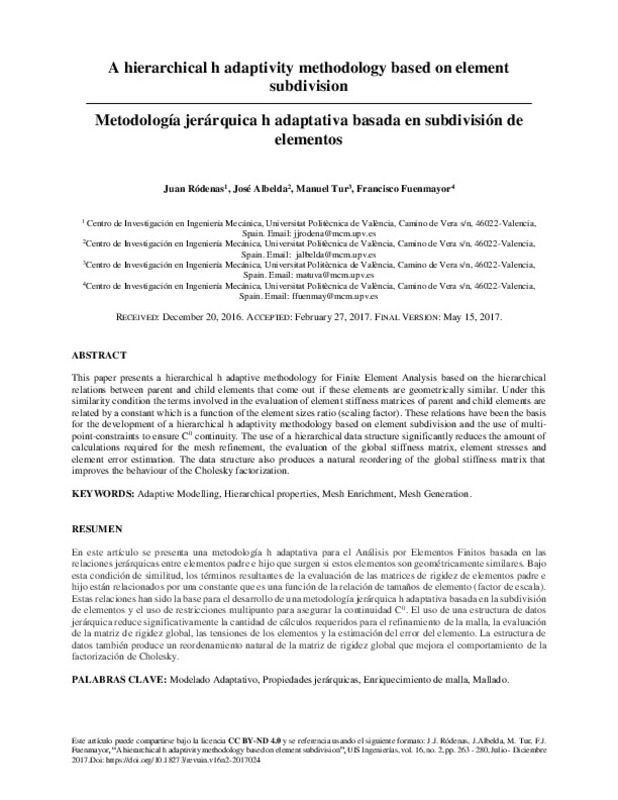JavaScript is disabled for your browser. Some features of this site may not work without it.
Buscar en RiuNet
Listar
Mi cuenta
Estadísticas
Ayuda RiuNet
Admin. UPV
A hierarchical h adaptivity methodology based on element subdivision
Mostrar el registro sencillo del ítem
Ficheros en el ítem
| dc.contributor.author | Ródenas, J.J.
|
es_ES |
| dc.contributor.author | Albelda Vitoria, José
|
es_ES |
| dc.contributor.author | Tur Valiente, Manuel
|
es_ES |
| dc.contributor.author | Fuenmayor Fernández, Francisco-Javier
|
es_ES |
| dc.date.accessioned | 2018-10-07T04:30:04Z | |
| dc.date.available | 2018-10-07T04:30:04Z | |
| dc.date.issued | 2017 | es_ES |
| dc.identifier.issn | 1657-4583 | es_ES |
| dc.identifier.uri | http://hdl.handle.net/10251/109825 | |
| dc.description.abstract | [EN] This paper presents a hierarchical h adaptive methodology for Finite Element Analysis based on the hierarchical relations between parent and child elements that come out if these elements are geometrically similar. Under this similarity condition the terms involved in the evaluation of element stiffness matrices of parent and child elements are related by a constant which is a function of the element sizes ratio (scaling factor). These relations have been the basis for the development of a hierarchical h adaptivity methodology based on element subdivision and the use of multipoint-constraints to ensure C0 continuity. The use of a hierarchical data structure significantly reduces the amount of calculations required for the mesh refinement, the evaluation of the global stiffness matrix, element stresses and element error estimation. The data structure also produces a natural reordering of the global stiffness matrix that improves the behaviour of the Cholesky factorization. | es_ES |
| dc.description.abstract | [ES] En este artículo se presenta una metodología h adaptativa para el Análisis por Elementos Finitos basada en las relaciones jerárquicas entre elementos padre e hijo que surgen si estos elementos son geométricamente similares. Bajo esta condición de similitud, los términos resultantes de la evaluación de las matrices de rigidez de elementos padre e hijo están relacionados por una constante que es una función de la relación de tamaños de elemento (factor de escala). Estas relaciones han sido la base para el desarrollo de una metodología jerárquica h adaptativa basada en la subdivisión de elementos y el uso de restricciones multipunto para asegurar la continuidad C0 . El uso de una estructura de datos jerárquica reduce significativamente la cantidad de cálculos requeridos para el refinamiento de la malla, la evaluación de la matriz de rigidez global, las tensiones de los elementos y la estimación del error del elemento. La estructura de datos también produce un reordenamiento natural de la matriz de rigidez global que mejora el comportamiento de la factorización de Cholesky. | es_ES |
| dc.description.sponsorship | The authors wish to thank the Spanish Ministerio de Economía y Competitividad for the fiancial support received through the project DPI2013-46317-R and the Generalitat Valenciana through the project PROMETEO/2016/007. The support of the Universidad Politécnica de Valencia is also acknowledged. The authors also want to thank Ana Ródenas’s help in the translation of this paper. | |
| dc.language | Inglés | es_ES |
| dc.publisher | Universidad Industrial de Santander | es_ES |
| dc.relation.ispartof | Revista UIS Ingenierías | es_ES |
| dc.rights | Reconocimiento - Sin obra derivada (by-nd) | es_ES |
| dc.subject | Adaptive Modelling | es_ES |
| dc.subject | Hierarchical properties | es_ES |
| dc.subject | Mesh Enrichment | es_ES |
| dc.subject | Mesh Generation | es_ES |
| dc.subject.classification | INGENIERIA MECANICA | es_ES |
| dc.title | A hierarchical h adaptivity methodology based on element subdivision | es_ES |
| dc.title.alternative | Metodología jerárquica h adaptativa basada en subdivisión de elementos | es_ES |
| dc.type | Artículo | es_ES |
| dc.identifier.doi | 10.18273/revuin.v16n2-2017024 | es_ES |
| dc.relation.projectID | info:eu-repo/grantAgreement/MINECO//DPI2013-46317-R/ES/PERSONALIZACION DE IMPLANTES MEDIANTE MODELOS DE ELEMENTOS FINITOS A PARTIR DE IMAGENES MEDICAS 3D/ | es_ES |
| dc.relation.projectID | info:eu-repo/grantAgreement/GVA//PROMETEO%2F2016%2F007/ES/Modelado numérico avanzado en ingeniería mecánica/ | es_ES |
| dc.rights.accessRights | Abierto | es_ES |
| dc.contributor.affiliation | Universitat Politècnica de València. Departamento de Ingeniería Mecánica y de Materiales - Departament d'Enginyeria Mecànica i de Materials | es_ES |
| dc.description.bibliographicCitation | Ródenas, J.; Albelda Vitoria, J.; Tur Valiente, M.; Fuenmayor Fernández, F. (2017). A hierarchical h adaptivity methodology based on element subdivision. Revista UIS Ingenierías. 16(2):263-280. https://doi.org/10.18273/revuin.v16n2-2017024 | es_ES |
| dc.description.accrualMethod | S | es_ES |
| dc.relation.publisherversion | https://doi.org/10.18273/revuin.v16n2-2017024 | es_ES |
| dc.description.upvformatpinicio | 263 | es_ES |
| dc.description.upvformatpfin | 280 | es_ES |
| dc.type.version | info:eu-repo/semantics/publishedVersion | es_ES |
| dc.description.volume | 16 | es_ES |
| dc.description.issue | 2 | es_ES |
| dc.relation.pasarela | S\359293 | es_ES |
| dc.contributor.funder | Generalitat Valenciana | es_ES |
| dc.contributor.funder | Ministerio de Economía, Industria y Competitividad | es_ES |








